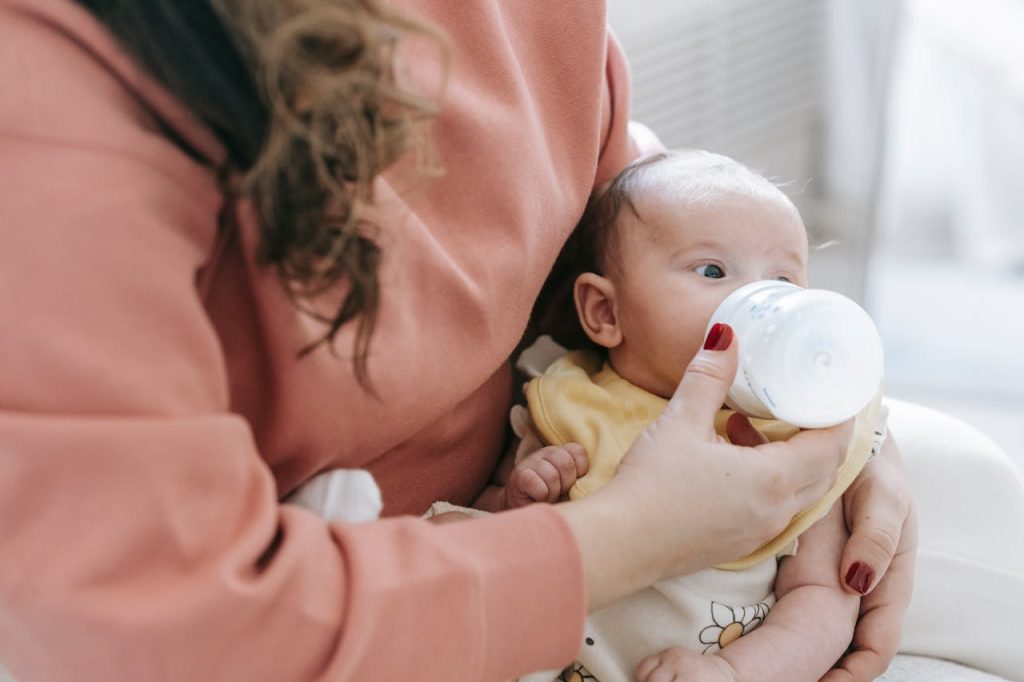Feeding your little one on the go sounds super convenient, doesn’t it? Picture this: You’re halfway through a long drive, the baby starts fussing, and you think, “Why not just feed her in the car seat?” But then, you pause. Is it safe? Legal? Smart? These questions prove that you, as a conscious parent, are thinking correctly.
Let’s dive deep into the do’s, don’ts, and absolutely-never-evers of feeding a baby in a car seat.
Understanding the Basics of Feeding in a Car
You might be thinking, “If feeding in the car is so common, what’s the point?” Actually, there are some important considerations behind this simple act. This act can have different impacts on the baby’s safety, health risks, and your own sense of responsibility. So it’s very important to know the basics of these issues before feeding your baby in the car.

Why Parents Consider Feeding in Car Seats
If you’ve ever been stuck in traffic with a wailing baby, you know the desperation. Parents often feed babies in car seats to:
- Calm a hungry or cranky baby
- Save time on long trips
- Avoid roadside stops during bad weather
- Soothe a baby before sleep
But convenience sometimes comes at a cost.
Safety First: What Experts Say
Can you feed a baby in a car seat? — As simple as this question may seem, the answer is equally important and complex. Why should you give this issue so much importance? Because when it comes to the safety and health of a child, nothing can be taken lightly. Experts have repeatedly said that it is most important to know and follow safety guidelines before establishing any habit.
Can You Feed a Baby in a Car Seat While Not Moving?
Yes, you can feed a baby in a car seat while the car is parked. But here’s the catch — supervision is crucial. Even when stationary, a reclined baby is not in an ideal position for swallowing. The risk of choking still exists.
Is It Safe to Bottle Feed a Baby in a Car Seat While Parked?
Safer than while moving? Sure. Totally safe? Not quite. A bottle can tilt in a way that floods the baby’s mouth, especially if the baby can’t control the flow. Always hold the bottle yourself — never prop it up.
Can I Breastfeed My Baby in a Moving Car?
This is a hard no. First off, it’s unsafe for both of you. Baby should always be in a secure, fastened seat. And you? You need to be seat-belted too. Breastfeeding while unbuckled in a moving car is a serious safety hazard.
Feeding While Parked vs. Moving: What’s the Difference?
Same car, same seat—yet the situation can be completely different. Are you driving or parked? Many parents think, “What’s the harm in feeding your baby while the car is moving?” But do we know the real difference? In this section, we’ll explain in depth what the risks or benefits may be between feeding your baby in a moving car and while parked.
Pros and Cons of Feeding in a Parked Car
Pros:
- Reduces stress without pulling over too long
- Offers a quick break without breaking the flow of a trip
Cons:
- Baby’s position isn’t ideal for digestion
- Sanitation might be compromised
The Dangers of Feeding in a Moving Car
- Increased choking risk due to bumps and turns
- No immediate access to help if baby gags
- Distraction for the driver (aka, you or your partner)
- Serious safety hazards if the adult is unbuckled to feed
Choking Hazards: What Every Parent Must Know
Baby safety during feeding is not limited to clean food or a comfortable seat. One of the biggest risks is choking or getting something stuck in the throat. Did you know that even just a spoonful of food can sometimes cause a big danger? So in this section, we will discuss which foods are risky and how you can be alert in advance.
How Positioning Affects Safe Swallowing
Car seats are designed for safety — not feeding. Babies are reclined, which means food and liquid can pool in the back of their throat. It’s a little like trying to drink while lying in a recliner — not ideal, right?
Common Mistakes That Increase Choking Risks
- Feeding too fast or too much at once
- Using a nipple with an incorrect flow rate
- Leaving baby unsupervised with a bottle
- Feeding solids in the seat (huge no-no)

Legal and Ethical Concerns Around Feeding in Cars
Now it’s not just safety that needs to be considered—it’s also legal and ethical. “Can you feed a baby in a car seat?” is not just a question of real risk, but also of understanding what the law says and what you should do as a responsible parent. If you don’t follow certain rules, you could face fines or even encounter dangerous situations.
Child Passenger Safety Laws by Region
Many countries have strict laws requiring children to remain buckled and in a proper car seat at all times. Feeding — especially breastfeeding — while unbuckled may violate these laws and could land you a fine or worse in case of an accident.
Parental Responsibility: Doing the Right Thing
Just because something isn’t illegal doesn’t mean it’s a good idea. Ask yourself: “If something goes wrong, can I react quickly enough?”
Real-World Scenarios from Moms and Dads
Theoretical discussions are one thing, but real life is another! Do you agree with this? Yes, of course, we all have to. Many parents face such decisions every day—when to feed, where to feed, and how to handle the issue safely. Now let’s hear some real stories that will help you a lot while making a decision.
Feeding on a Road Trip: What Actually Works
Experienced parents recommend:
- Planning feeding stops into your GPS
- Using rest areas for safe, relaxed meals
- Bringing pre-warmed bottles in insulated pouches
The Midnight Snack Stop: A Lifesaver or Risk?
At night, it might seem tempting to “dream feed” on the road. Don’t. Pull over, turn on a soft light, feed slowly, and burp your baby properly. It’s not just about feeding — it’s about feeding safely.
Alternative Strategies to Feeding in the Car
Pre-Trip Feeding Planning
Feed your baby right before hitting the road. Think of it as fueling up — but for baby tummies.
Smart Break Scheduling
Aim for a break every 2-3 hours. Plan stops near family-friendly rest areas while traveling with a baby where you can stretch, change diapers, and feed.
Essentials to Keep in Your Car for Baby Feeding
When you want to feed your baby on the go, you won’t have everything you need at hand. Experts say it’s best to prepare a little in advance. With a smart feeding kit, you can satisfy your baby’s hunger at any time, easily and safely. So your question is, what are the must-have items in the car? Below is a list of them.
Must-Have Feeding Supplies Checklist
- Clean bibs and burp cloths
- Bottles and formula dispensers
- Wipes and sanitizer
- Extra outfits (accidents happen!)
- Small trash bags
Hygiene Tips When Feeding on the Go
Keep hand sanitizer in your glove box and sterilize bottles after every use. Never leave milk-based bottles in a hot car — bacteria grows faster than you think.

When It’s Absolutely Okay to Feed in a Car Seat
When you’re on a long journey and your baby is hungry, feeding him in the car seat may seem a bit convenient. However, the question remains—Is it always safe? Let’s find out more about this.
Age and Developmental Stage Considerations
Older babies (around 9+ months) who can sit well and handle bottle-feeding on their own may do okay in brief feeding sessions while parked.
Feeding with Close Supervision in Safe Conditions
If you’re:
- Parked safely
- Holding the bottle
- Watching for signs of choking
Then short feeding sessions may be fine.
When to Completely Avoid Feeding in the Car
As convenient as it may seem, feeding your baby in a car seat is not always safe. There are some situations where it should be avoided altogether. Let’s find out about these below.
Signs It’s Not the Right Time or Place
- Baby is too sleepy
- Car is moving
- You’re unable to supervise properly
- Bottle feeding needs both hands while you’re multitasking
Emergency Scenarios and Prioritizing Safety
If you sense anything is off — baby coughing, gagging, car starting to move — stop feeding immediately.
Expert Opinions: Pediatricians and Road Safety Advisors
Pediatricians and road safety experts offer some important tips on feeding babies in the car. They explain how to be careful from both a safety and health perspective and how you can ensure a safe feeding experience for your baby.
Pediatric Viewpoint on Digestion and Positioning
Pediatricians generally discourage feeding in a car seat unless absolutely necessary. The reclining angle isn’t great for digestion and can increase gas and reflux.
Road Safety Authorities on Feeding in Motion
Authorities are clear: feeding in a moving vehicle is unsafe and can be deadly. No snack, bottle, or shortcut is worth the risk. So you should keep this in mind.
Building Healthy Feeding Habits from the Start
It is very important for a child to develop healthy eating habits, and it starts from an early age. If you start right, your child will develop a good attitude towards food. Do you know how beneficial it is for them? It will also help with their physical and mental health. Let’s learn some easy ways to teach children proper eating and serve healthy food to them.
Creating a Routine Outside the Car
Try to feed your baby at consistent locations — your home, daycare, or even a park bench. This helps them associate mealtime with comfort and stability.
Teaching Baby to Eat Safely at the Table
Car seats aren’t substitutes for high chairs. Encouraging your baby to eat upright — and eventually, independently — builds long-term healthy eating habits.
FAQs About Feed a Baby In a Car Seat
1. Is it ever safe to breastfeed in a moving car?
No. It’s unsafe for both mom and baby due to lack of seatbelt use.
2. Can I bottle-feed my baby in a parked car?
Yes, but only under close supervision and with the car engine off.
3. What are the risks of feeding in a car seat?
Choking, poor digestion, bottle propping risks, and bacterial contamination.
4. Is it okay to give snacks to toddlers in car seats?
Only soft, non-chokeable items and only when parked with supervision.
5. Can babies choke easily in car seats?
Yes, especially if reclined and unsupervised during feeding.
6. Are there car seat-friendly feeding bottles?
No bottle is truly “car seat-friendly” — feeding depends more on positioning and supervision.
7. Is dream feeding in the car recommended?
Not really. It’s safer and more effective to stop, feed, and burp properly.
8. How can I keep my baby calm without feeding on the road?
Use soft music, white noise, or comfort toys to soothe.
9. What’s the best way to feed a baby during long drives?
Plan frequent breaks and use safe, upright feeding methods.
10. Should I stop the car every time my baby cries from hunger?
Ideally, yes. Baby’s needs come first, and safety comes before convenience.
All About The Article
So, can you feed a baby in a car seat? Technically, yes — if you’re parked, present, and careful. But is it the best or safest option? Not always. Every baby is different, but the rule of thumb remains: safety over convenience, always.
And if you’re unsure whether your baby’s seat is still properly fitted, learn when to remove the newborn insert from a car seat to keep them as safe as possible.






